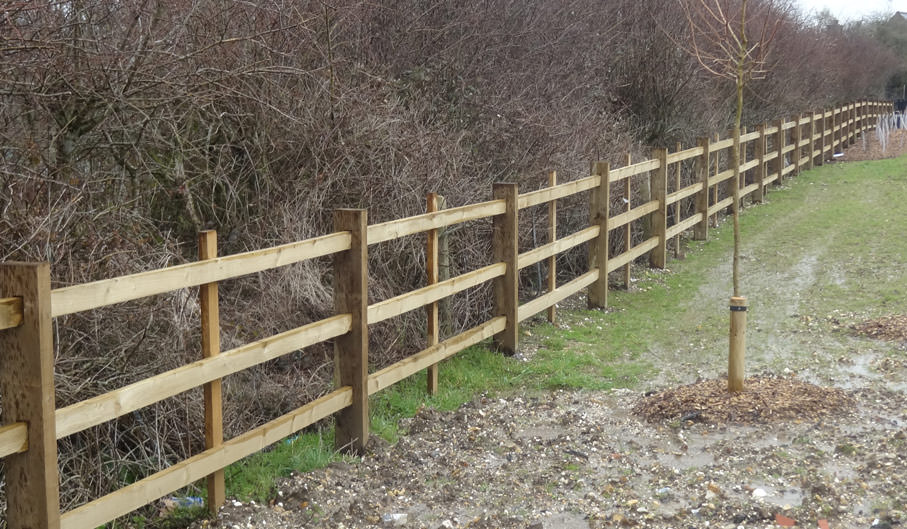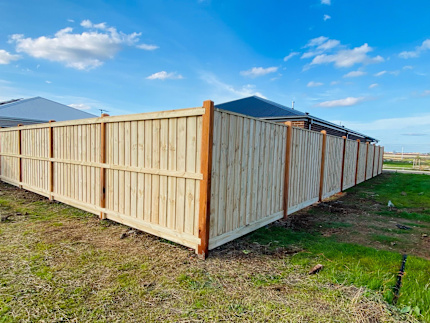The Essential Guide to Hiring the Right Fence Contractors in Auckland
The Essential Guide to Hiring the Right Fence Contractors in Auckland
Blog Article
A Comprehensive Guide to Fencing Install: What You Need to Find Out About Secure Fencing Provider
When it comes to mounting a fencing, you've got a great deal to contemplate. You'll need to analyze your residential property and decide if you desire to tackle the installment yourself or employ an expert.
Recognizing Various Sorts Of Fencing Materials
When you're picking a fencing, recognizing the different sorts of secure fencing materials is vital. Each product supplies distinct advantages and downsides, impacting your decision. Timber supplies a timeless look and can be tailored, however it calls for routine upkeep and may rot over time. Plastic is low-maintenance and long lasting, withstanding fading and bugs, however it can be costlier upfront. Chain-link fence is economical and useful for confining big areas, though it lacks personal privacy and aesthetic charm. Metal secure fencing, like wrought iron or aluminum, provides stamina and beauty however may need corrosion security. Composite products mix the very best of timber and plastic, using resilience with an all-natural appearance. Consider your spending plan, desired visual appeals, and maintenance choices when evaluating these options. Inevitably, picking the ideal material will certainly aid you create a fencing that meets your needs and boosts your residential or commercial property's value.
Analyzing Your Property and Secure Fencing Demands
Before you begin your fence setup, it's vital to analyze your property boundaries and the objective of your fence. Understanding local laws and authorizations will also help you stay clear of any kind of lawful problems down the line. By considering these aspects, you'll guarantee your fence fulfills both your requirements and area criteria.
Property Borders and Lines
Recognizing your property boundaries is necessary for a successful fencing setup, as it not just assists you identify where your fence will certainly go however additionally assures you're valuing your neighbors' room. Begin by evaluating your residential or commercial property act or study, which commonly lays out the exact borders. You may likewise want to seek advice from a specialist property surveyor if you're unsure.
Once you have actually developed your borders, mark them clearly with risks or flags. This visual aid will lead you during the installment and protect against any type of disputes with neighbors. Keep in mind, local zoning legislations may determine fence placement and elevation, so inspect those laws too. Taking these steps warranties your fence is correctly placed and compliant, making the whole process smoother for you.
Objective of Fence
Third, fence can define your residential property borders, making it clear where your area ends and your next-door neighbor's begins. A well-placed fencing can aid handle sound from close-by roadways or next-door neighbors and even keep pet dogs and kids safe. By evaluating your specific demands, you can pick the appropriate kind of fence to achieve these advantages effectively.

Local Rules and Permits
Just how can you guarantee your fence installation abides by local policies? Start by getting in touch with your neighborhood zoning workplace or metropolitan web site. Fence Builders. They commonly have standards about fencing elevation, products, and placement. You'll likewise desire to discover out if you need a license before starting your project. Some areas require authorizations for any kind of brand-new fencing, while others might just need them for taller structures.
Additionally, think about residential property lines and any type of easements on your land. Marking your boundaries can protect against conflicts with neighbors or possible legal issues. By understanding these laws in advance, you can stay clear of expensive errors and establish your fencing is built to last, enhancing both your building's value and your tranquility of mind.
Local Regulations and Permits for Secure Fencing
Before you start your fencing project, it is very important to examine regional policies and get any needed permits. Each city or county has its very own policies relating to fence height, materials, and positioning. These guidelines ensure that your fence abides by safety standards and area appearances.
You could require to send a fencing plan, describing dimensions and products. Some locations may also require a study to validate home limits.
Ignoring to comply with these laws can result in penalties or required removal of your fence, squandering both money and time. Take the time to research study and protect the correct licenses for a smooth setup procedure. This action is crucial in making certain your job straightens with local regulations and neighborhood standards.
Selecting Between DIY Installation and Specialist Services
Are you considering whether to tackle the fence installation on your own or employ a specialist? This decision depends upon several variables. Assess your skill level. If you're helpful and have experience with similar tasks, do it yourself may save you cash. Be sincere about your abilities; mistakes can lead to additional prices and headaches.
Following, think about the moment dedication. Installing a fence takes some time, and if you're juggling an active routine, employing an expert can guarantee it gets done successfully. Additionally, think of the complexity of the job. If your lawn has difficult surface or particular layout needs, professionals bring know-how that can make a difference.
Finally, aspect in regional regulations. A professional understands the authorizations and codes required, helping you stay clear of potential penalties. Inevitably, evaluate your skills, time, complexity, and regulations to make the very best selection for your fence task.
Step-by-Step Overview to Fencing Setup
Once you've made a decision to move onward with your fencing installment, complying with a structured step-by-step strategy will guarantee a smooth procedure. additional hints Beginning by marking the fence line with stakes and string to visualize the design. Next, inspect neighborhood policies to verify conformity with elevation and home lines.
Dig message openings a minimum of 2 feet deep, spaced according to your fence kind-- generally 6 to 8 feet apart. Place the messages right into the holes and load them with concrete for stability. When the messages are established, attach the horizontal rails or panels, ensuring they're degree.
Check for any kind of loose connections and make necessary adjustments. Your fence should now be ready to enhance your property and provide the personal privacy or protection you need!
Upkeep Tips for Durability of Your Fencing
To keep your fencing looking excellent and enduring longer, normal upkeep is vital. You ought to set up a cleansing schedule, inspect for any kind of damage, and apply safety finishes as needed. By remaining proactive with these tasks, you'll ensure your fence continues to be sturdy and appealing for several years ahead.
Regular Cleansing Arrange
Beginning by washing navigate here your fence with water at the very least once every season to get rid of dust and debris. Do not fail to remember to examine for any type of corrosion on steel fences; a cable brush can aid eliminate it, adhered to by a coat of rust-resistant paint. Maintaining your fence clean not just boosts its appearance however also prolongs its life, conserving you money in the long run.
Inspect for Damage
On a regular basis inspecting your fencing for damage is important if you wish to maintain its integrity and longevity. Beginning by strolling around your fencing to search for noticeable signs of wear, such as splits, loosened boards, or corrosion. Pay unique attention to the base and articles, where moisture can trigger significant concerns. If you observe any type of damages, bear in mind and identify the necessity of repairs. Attending to tiny issues quickly can prevent them from intensifying right into bigger, extra costly issues. Look for any indications of parasites, like termites or woodpeckers, that can compromise your fence's structure. Lastly, confirm that your fencing continues to be secure by checking for any leaning or sagging sections. Normal inspections will keep your fence looking terrific and working appropriately for many years to come.
Apply Safety Coatings
After evaluating your fencing for damage, using safety finishes is an essential step in ensuring its long life - Fence Contractors. If your fencing is plastic or metal, think about a UV-protective spray or paint to avoid fading and corrosion.
See to it to clean up the surface extensively prior to application, as dirt and crud can threaten the covering's performance. Use the layer in completely dry climate for far better attachment, and do not neglect to adhere to the supplier's guidelines for the very best outcomes. On a regular basis reapply every few years to maintain your fence looking excellent and standing strong against the elements.
Cost Factors To Consider and Budgeting for Your Fencing Job
When intending your fencing job, comprehending price factors to consider is vital to remaining within budget. Beginning by figuring out the sort of material you want, as prices can vary greatly between timber, vinyl, and steel. Do not forget to element in labor prices-- hiring specialists could conserve you time however can increase your overall expenses.
Next, gauge your residential property to determine the direct footage required, as this straight effects material prices. Additionally, consider any licenses you may require, which can include in your budget plan.

Last but not least, it's a great idea to reserve a contingency fund for unexpected expenses. By intending thoroughly and taking into consideration these variables, you can develop a realistic spending plan that fulfills your fence needs without damaging the financial institution.
Regularly Asked Concerns
The length of time Does the Typical Fencing Installation Take?
The standard fence installment generally takes one to three days, depending on the fencing kind and size of your lawn. You'll need to take right into account any type of hold-ups because of weather or permit demands also.
What Should I Do if My Fencing Is Damaged?
If your fencing his comment is here is harmed, first assess the extent of the damages. Repair small issues on your own, but also for major problems, think about contacting a specialist. Do not wait as well long; it'll assist avoid further difficulties.
Can I Set Up a Fencing on an Incline?
Yes, you can install a fencing on a slope. You'll need to change your installation approach, either by stepping the panels down or utilizing a racked design to guarantee security and appropriate alignment with the terrain.
What Are the Ideal Practices for Fence Painting?
To paint your fencing successfully, start with correct cleaning and sanding. Use top notch paint and apply in also strokes. Don't forget to choose the appropriate climate for paint, ensuring it's completely dry and light.
Just how Commonly Should I Check My Fence?
You ought to evaluate your fence at the very least twice a year, concentrating on indications of damage, rot, or corrosion. Normal checks aid you capture problems early, guaranteeing your fencing stays durable and visually appealing much longer.
Report this page